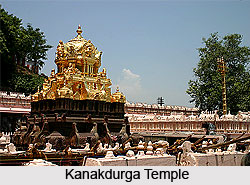Paschim Medinipur district has been carved out from the erstwhile district of Midnapore, and it came into existence on 1st January 2002. It has a total geographical area of 9295.28 sq. kms and a population of 5193411 as per census 2001. The district is primarily agricultural in nature, with cultivation being the chief livelihood of a majority of the people. Paddy occupies the first place in production. The district has a suitable agro-climatic condition for cultivation of mulberry and horticulture crops such as mango, banana, guava, lemon, mousambi, papaya, cashew and jackfruit.
 Location of Paschim Medinipur District
Location of Paschim Medinipur District
Paschim Medinipur is situated in the south-western side of West Bengal. It is bounded by Bankura district and Purulia district in the north, Mayurbhanj district and Balasore district of Orissa in the south, Hooghly district and Purba Medinipur district in the east and Singhbhum district of Jharkhand and Purulia district of West Bengal in the west. The district lies between 21 degrees 47 minutes and 23 degrees north latitude, and between 86 degrees 40 minutes and 87 degrees 52 minutes east longitude. National Highway No.6 and 60 run through the district and offer high-speed connectivity to various parts of the district and other cities.
Geography of Paschim Medinipur District
The district has an area of 9, 29, 528 hectares. Out of this the total forest area is 173038 hectares which constitutes about 18.61 percent of its total geographical area. Net area under cultivation is 5, 85, 222 hectares. The climate is tropical and the land surface of the district is characterised by hard rock uplands, lateritic covered area, and flat alluvial and deltaic plains. Extremely rugged topography is seen in the western part of the district and rolling topography is experienced consisting of lateritic covered area. These rolling plains gradually merge into flat alluvial and deltaic plains to the east and south east of the district. The soil is fairly fertile. Normal rainfall is 1560 mm and average rainfall in the district is 1656 mm.
The climate is characterized by hot summer, cold winter, abundant rainfall and humidity from 1450 mm to 1560 mm per year. Kangsabati, Silabati, Subarnarekha, Dulongs, Keleghai and their tributaries are the main rivers of the district. Irrigation is provided to both kharif and rabi crops. Kangsabati canal system is the main irrigation scheme. Ground water supports supplementary irrigation. 63 percent of the net cultivable area is irrigated. The ground water development and judicious management of the surface water are vital factors for promoting modern agriculture through high yielding and remunerative crops, particularly in the western parts of the district.
Economy of Paschim Medinipur District
The district is predominant in agriculture with 70 percent of the population dependent on agriculture and allied activities. At the same time, huge potential exists for various industrial activities in the district. Presently, the main industrial area is around Kharagpur. Small Scale industrial clusters are coming up in Jhargram, Chandrakona Road, Garhbeta and Medinipur. These units are based on agriculture, forest produce, animal husbandry, chemicals and engineering.
The existing industries where improvement, technological up-gradation and further investments can be done profitably include units based on mat stick, wood, floriculture, pottery, stone carving and crushing, jewellery of conch shell, babui grass, cashew processing and packaging, manufacture of gums, manufacture of incense sticks, soft toys, bamboo and cane work, sal leaf plates, various jute products, sericulture, tussar silks, poultry cattle feed making, potato chips, mango and other fruits pickles, jams, milk chilling, processing and dairy products, processing, packaging and marketing of cereals, pulses, chilli and turmeric powder, rice huller, muri and chira, rice mills, bee keeping, oil mills, medicinal plants, fish processing for export and mushroom processing. Handloom is a traditional industry which engages a considerable number of artisans. The Diesel and EMU workshop has opened scope for small scale and ancillary units. The strategic location of the town has helped to establish some consumer goods, engineering, plastic and chemical industries.
 Culture of Paschim Medinipur District
Culture of Paschim Medinipur District
Paschim Medinipur is the land of freedom fighters, social reformers and also the mother land of martyrs like Khudiram Bose, Matangini Hazra, Prodyat Bhattacharya, Hemchandra Kanungo and the pioneer of educational renaissance of Bengal. This district has also been enriched with diversified socio-cultural activities such as tradition and culture of tribal groups like the Lodhas, Sabars and Santhal Tribe.
Education in Paschim Medinipur District
Paschim Medinipur district comprises innumerable colleges and educational institutes like Kharagpur College, Bhatter College, Indian Institute of Technology, Kharagpur, Hijli College, Institute of Science and Technology, Jhargram Raj College, Garhbeta College, K.D. College of Commerce and General Studies and many others.
Tourism in Paschim Medinipur District
Important tourists spots in the district are Gurguripal Eco-tourism, Chandra Eco-tourism, Arrahbari, Pathra, Karnagarh, Mohoboni, Parimal Kanan, Ganganirdanga, Rupa Ghagra, Kurumbera Durga, Chilkigarh, Jhargram Rajbati, Odolchua, Kanakdurga Mandir, Kankarajhore, Hatibari, Chichira, Taraferini, Kanaisore Pahar, Banspahari, Birsingha, Narajole Rajbari etc.
The district is well known for the production of mulberry and tussar silks and silk sarees from Midnapore are much in demand. Kharagpur, an important junction of the South-Eastern Railway is located centrally in the district. It provides connectivity to all parts of the country for passengers as well as goods. Haldia is the nearest port which is well connected to various parts of the district. The district consists of 4 Sub-divisions, 27 Police Stations, 29 Blocks and 8 Municipalities.






